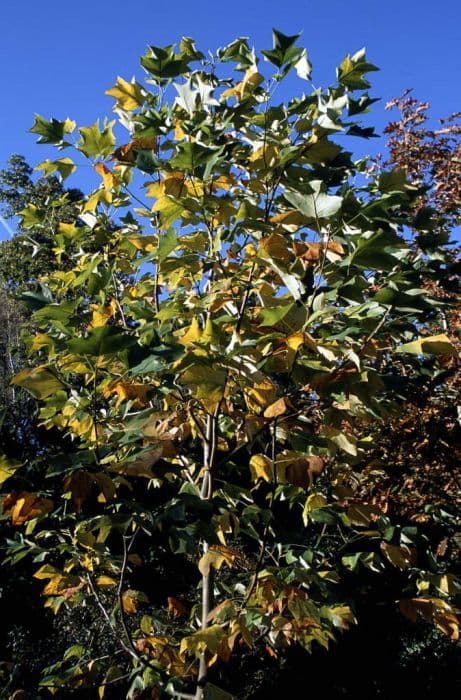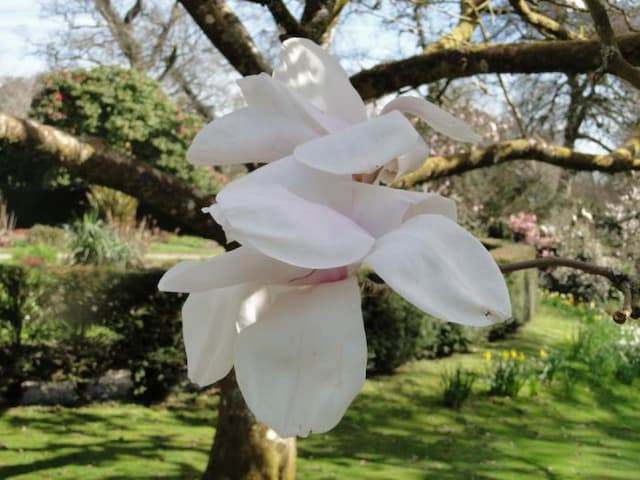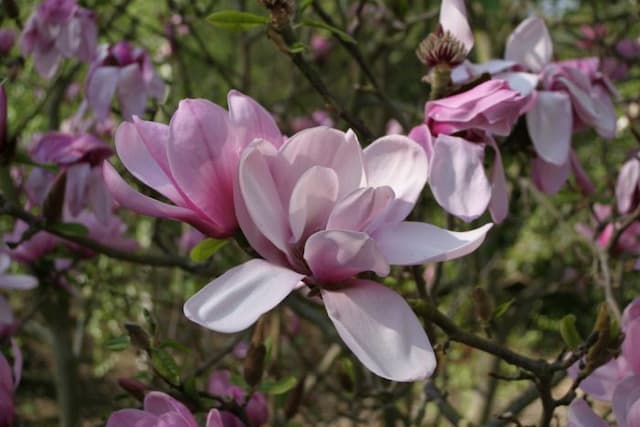Campbell's Magnolia Magnolia campbellii (Raffillii Group) 'Charles Raffill'

ABOUT
The Magnolia campbellii, commonly known as the Campbell's magnolia, is a captivating plant with an impressive display of floral beauty. The 'Charles Raffill' variety is particularly noted for its striking blooms. These flowers emerge prior to the foliage in late winter to early spring, presenting a breathtaking spectacle against the bare branches. The flowers of 'Charles Raffill' are large and showy, with a classic cup-and-saucer shape characteristic of many magnolias. The petals are bold and inviting, with a rich pink color that can vary in intensity, sometimes showing lighter shades or deepening towards a more intense hue at the base. The blossoms are composed of many tepals — modified structures that are not differentiated into separate petals and sepals — which form the enchanting, layered look of the bloom. Adding to the visual appeal, the flowers exude a delightful fragrance that can permeate the surrounding area, attracting pollinators and enchanting passersby. As the flowering season progresses, the blooms eventually give way to the arrival of the leaves. The foliage of the Campbell's magnolia is also attractive, with leaves that are large, oval-shaped, and have a glossy green surface. They create a lush backdrop for the subsequent fruits, which are cone-like structures that turn reddish-brown as they mature and release individual seeds. Overall, the Campbell's magnolia 'Charles Raffill' is a plant with an exceptional decorative quality, known for the extravagant floral display and pleasing fragrance, accented by attractive green foliage. It is a prominent feature in gardens and landscapes where it can be accommodated, providing a radiant burst of spring color and contributing to the aesthetics of its surroundings.
About this plant
 Names
NamesFamily
Magnoliaceae.
Synonyms
Charles Raffill Magnolia, Campbell's Magnolia, Himalayan Magnolia.
Common names
Magnolia campbellii 'Charles Raffill'
 Toxicity
ToxicityTo humans
Magnolia campbellii, commonly known as Campbell's magnolia, is generally considered non-toxic to humans. There are no significant reports of toxicity upon ingestion of parts of this plant. However, as with any plant, individuals could potentially experience an allergic reaction, or gastrointestinal discomfort if large quantities are ingested. It's advisable to avoid eating plant material that is not typically recognized as food to prevent any possible adverse effects.
To pets
Campbell's magnolia is also not known to be toxic to pets. It is not typically listed on toxic plant databases for dogs and cats. Therefore, if a pet were to ingest parts of this magnolia, they are not expected to suffer from poisoning symptoms. However, ingestion of non-food items can lead to gastrointestinal upset in some pets, so it is a good practice to prevent pets from chewing on or ingesting plants.
 Characteristics
CharacteristicsLife cycle
Perennials
Foliage type
Deciduous
Color of leaves
Green
Flower color
Pink
Height
30 feet [9 meters]
Spread
20 feet [6 meters]
Plant type
Tree
Hardiness zones
7
Native area
Himalayas
Benefits
 General Benefits
General Benefits- Ornamental Value: Magnolia campbellii 'Charles Raffill' features large, showy flowers that add aesthetic appeal to gardens and landscapes.
- Attracts Pollinators: The blooms can attract bees and other pollinating insects, contributing to the health of your garden ecosystem.
- Shade Provider: As a large tree, it can offer ample shade during hot summers, creating a cooler microclimate.
- Seasonal Interest: With its spring bloom, it provides seasonal interest and can be a focal point in the garden during that time.
- Privacy Screen: When planted in groups, it can act as a natural privacy screen or windbreak, enhancing the usability and comfort of outdoor spaces.
- Habitat Support: The tree can offer habitat to birds and other wildlife, contributing to biodiversity.
- Erosion Control: The root system can help stabilize soil and prevent erosion on slopes or banks.
- Street Trees: Due to their grand stature, they are suitable for use as street trees in urban landscaping, where space and conditions allow.
- Wood Usage: The wood from Magnolia trees is sometimes used in furniture making or woodworking, providing material value.
 Medical Properties
Medical PropertiesThis plant is not used for medical purposes.
 Air-purifying Qualities
Air-purifying QualitiesThis plant is not specifically known for air purifying qualities.
 Other Uses
Other Uses- Magnolia campbellii flowers can be used to create natural dyes for fabrics, providing a range of colors depending on the mordants used during the dyeing process.
- The wood of Magnolia campbellii is sometimes used in furniture making, particularly in the creation of fine, decorative pieces where its moderate hardness and grain can be appreciated.
- The large leaves of the Magnolia campbellii can be utilized in floral arrangements as a lush, green backdrop that accentuates the other colors in the display.
- Its petals can be candied and used as an exotic, edible decoration on desserts or in culinary presentations for a touch of elegance.
- The dried bark from the Magnolia campbellii might serve as a natural mulch, offering a source of nutrients to the soil as it decomposes.
- Due to its striking appearance, Magnolia campbellii is used in landscape photography as a subject to capture the essence of spring and natural beauty.
- In artistic works, Magnolia campbellii can be depicted in paintings and illustrations, often symbolizing nobility and perseverance in various cultures.
- The tree's seed cones can be utilized in craft projects, either on their own or painted, as they have a unique texture and shape.
- During special events or ceremonies, Magnolia campbellii branches with buds or blossoms can be displayed indoors to add natural fragrance and beauty to the venue.
- Extracts from the petals of Magnolia campbellii have been used in perfumery to create unique floral scents for high-end fragrances.
Interesting Facts
 Feng Shui
Feng ShuiThe Magnolia is not used in Feng Shui practice.
 Zodiac Sign Compitability
Zodiac Sign CompitabilityThe Magnolia is not used in astrology practice.
 Plant Symbolism
Plant Symbolism- Perseverance and Determination: Magnolia 'Charles Raffill' often blooms in early spring, sometimes even while there's still frost. Its ability to thrive in harsh conditions symbolizes the strength to persevere through challenges.
- Nobility and Dignity: The magnolia tree is associated with nobility due to its impressive stature and commanding presence, reflecting a sense of dignity and poise.
- Femininity and Purity: The delicate and showy flowers of the magnolia often represent femininity, purity, and beauty in various cultures.
- Longevity and Permanence: Magnolias are known to be long-lived trees, which makes them a symbol of endurance and long-lasting nature.
- Spiritual Connection: In some cultural traditions, magnolias are seen as a connection to the spiritual realm, representing an awareness of the larger universe.
 Water
WaterThe Charles Raffill magnolia prefers consistently moist soil, so it should be watered deeply once a week. During hot or dry periods, watering frequency should increase to twice a week, ensuring that the soil doesn't dry out completely. Each watering session should involve soaking the soil around the root zone with about 1-2 gallons of water depending on the size and maturity of the plant. It's important to avoid overwatering, which can lead to root rot, so adjust the amount based on rainfall and the plant's response.
 Light
LightThe Charles Raffill magnolia thrives in full sun to partial shade conditions. For best growth and bloom production, choose a planting spot where the tree can receive at least 4-6 hours of direct sunlight daily while being somewhat shielded from the harsh afternoon sun, especially in hotter climates. An eastern or western exposure that receives morning or late afternoon light would be ideal for this magnolia.
 Temperature
TemperatureThe Charles Raffill magnolia is hardy and can tolerate a wide range of temperatures, but it prefers a moderate climate. It can survive minimum temperatures down to about 0°F, but for optimal growth, it thrives in temperatures ranging from 60°F to 80°F. The magnolia can endure short periods of higher temperatures but protection from extreme heat and frost is beneficial.
 Pruning
PruningPruning the Charles Raffill magnolia should be done to maintain shape, remove damaged branches, or to improve air circulation within the canopy. The best time to prune is in the late winter or early spring before new growth begins. Prune sparingly, as magnolias do not require heavy pruning, focusing on dead or crossing branches. Prune every few years or as necessary to keep the tree healthy.
 Cleaning
CleaningAs needed
 Soil
SoilThe best soil mix for Magnolia Campbellii 'Charles Raffill' is one that is rich, well-draining, and slightly acidic with a pH of 5.5 to 6.5. A mixture of loamy soil, peat moss, and coarse sand or perlite can provide the right balance of nutrients, aeration, and moisture retention for optimal growth.
 Repotting
RepottingMagnolia Campbellii 'Charles Raffill' is typically not repotted as it is a larger tree, but when young, it may need repotting every few years until it is established enough to be planted in its final location outdoors.
 Humidity & Misting
Humidity & MistingMagnolia Campbellii 'Charles Raffill' thrives in moderate to high humidity levels, ideally between 40% to 70%. Maintaining sufficient humidity is important especially during the dry winter months.
 Suitable locations
Suitable locationsIndoor
Ensure bright indirect light, keep soil moist, and provide space to grow.
Outdoor
Plant in well-draining, acidic soil in partial to full sun.
Hardiness zone
7-9 USDA
 Life cycle
Life cycleMagnolia campbellii (Raffillii Group) 'Charles Raffill', commonly known as 'Charles Raffill's magnolia', germinates from seed, with its initial stage characterized by the emergence of a radical (root) and a plumule (shoot). The seedling stage sees the development of the first true leaves, with roots establishing in the soil. As it enters the vegetative stage, the plant experiences a period of growth where leaves, branches, and root systems expand, preparing it for eventual flowering. The flowering stage is marked by the opening of large, showy flowers, typically pink or purple, which are pollinated by insects. Following pollination, the plant produces seeds, encased in cone-like structures, that mature and are eventually dispersed to begin the next generation. Finally, as a perennial, 'Charles Raffill's magnolia' enters a cycle of dormancy during colder months and resumes growth in the spring, continuing this pattern for many years, potentially reaching over a century in age if conditions are favorable.
 Propogation
PropogationPropogation time
Spring to Summer
The most popular method of propagating Magnolia campbellii, commonly known as Campbell's Magnolia, is through semi-hardwood cuttings. This is typically done during the mid to late summer months. Cuttings should be about 4 to 6 inches (10 to 15 centimeters) long, with a few leaves left at the top. Rooting hormone is often applied to the cut end to facilitate root development. The prepared cutting is then placed in a well-draining soil mix, ensuring the leaf nodes (where leaves and buds emerge) are buried as these areas are where roots are most likely to sprout. The cutting needs to be kept moist and in a sheltered location with indirect sunlight until roots have formed, which can take several weeks. A plastic covering can help maintain humidity levels around the cutting, enhancing root formation.








![Magnolia [Felix Jury]](/_next/image?url=https%3A%2F%2Fplants-admin.emdemapps.com%2Fimages%2Fplants%2F%2Fimages%2F604b61a0b23b7.png&w=640&q=75)
